maven私服搭建
一、软件安装
地址:http://www.sonatype.org/nexus/thank-you-for-downloading/?dl=tgz
解压:
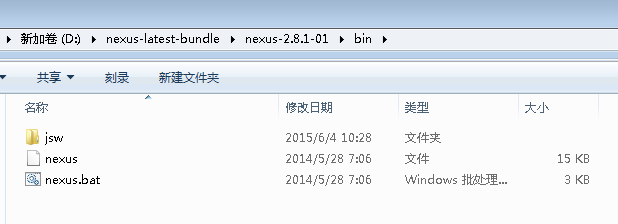
启动:
>> nexus start
打开:http://192.9.104.17:8081/nexus/#welcome
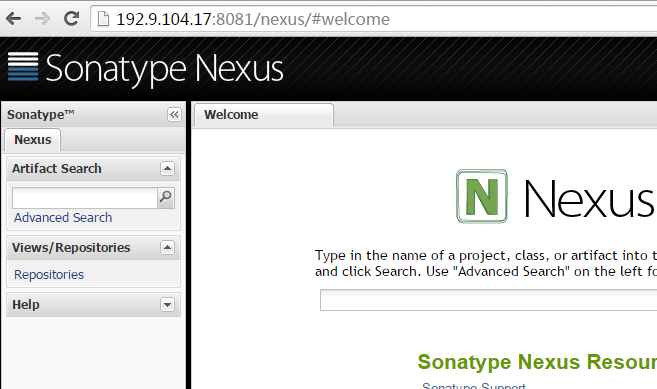
点击右上角,使用admin/admin123(默认管理员)登陆。
管理操作面板(修改代码库、镜像、用户权限管理等):
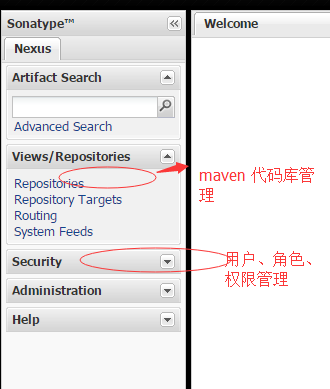
二、系统配置
默认的nexus 配置的镜像是无法使用的,需要我们把它设置为可行的,重新构建索引。

重新构建索引:

需要修改的仓库有三处:Central、Apache Snapshots、Codehaus Snapshots
另外,releases和snapshots两处的可以自动部署属性必须勾上,如下图:
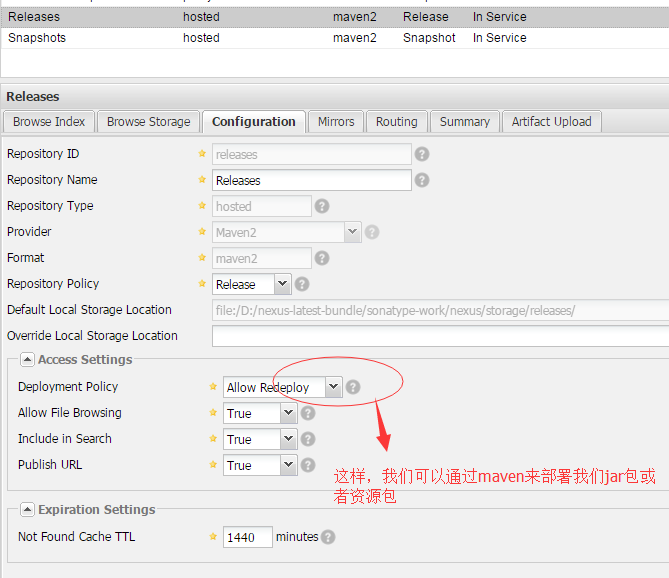
当然,你也可以通过界面来上传jar包。
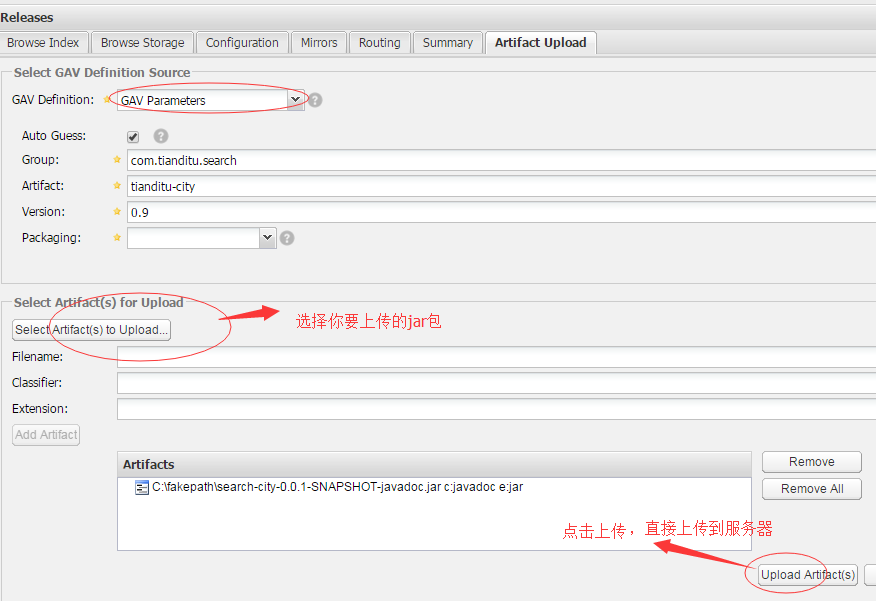
三、maven环境配置
1、确保你的环境中已经部署和正确配置了maven环境,具体如果安装maven不在此教程范畴之内。
2、到你当前登录的用户下的.m2目录下,创建一个setting.xml,内容如下:
<?xml version="1.0" encoding="UTF-8"?> <!--
Licensed to the Apache Software Foundation (ASF) under one
or more contributor license agreements. See the NOTICE file
distributed with this work for additional information
regarding copyright ownership. The ASF licenses this file
to you under the Apache License, Version 2.0 (the
"License"); you may not use this file except in compliance
with the License. You may obtain a copy of the License at http://www.apache.org/licenses/LICENSE-2.0 Unless required by applicable law or agreed to in writing,
software distributed under the License is distributed on an
"AS IS" BASIS, WITHOUT WARRANTIES OR CONDITIONS OF ANY
KIND, either express or implied. See the License for the
specific language governing permissions and limitations
under the License.
--> <!--
| This is the configuration file for Maven. It can be specified at two levels:
|
| 1. User Level. This settings.xml file provides configuration for a single user,
| and is normally provided in ${user.home}/.m2/settings.xml.
|
| NOTE: This location can be overridden with the CLI option:
|
| -s /path/to/user/settings.xml
|
| 2. Global Level. This settings.xml file provides configuration for all Maven
| users on a machine (assuming they're all using the same Maven
| installation). It's normally provided in
| ${maven.home}/conf/settings.xml.
|
| NOTE: This location can be overridden with the CLI option:
|
| -gs /path/to/global/settings.xml
|
| The sections in this sample file are intended to give you a running start at
| getting the most out of your Maven installation. Where appropriate, the default
| values (values used when the setting is not specified) are provided.
|
|-->
<settings xmlns="http://maven.apache.org/SETTINGS/1.0.0"
xmlns:xsi="http://www.w3.org/2001/XMLSchema-instance"
xsi:schemaLocation="http://maven.apache.org/SETTINGS/1.0.0 http://maven.apache.org/xsd/settings-1.0.0.xsd">
<!-- localRepository
| The path to the local repository maven will use to store artifacts.
|
| Default: ${user.home}/.m2/repository
<localRepository>/path/to/local/repo</localRepository>
--> <!-- interactiveMode
| This will determine whether maven prompts you when it needs input. If set to false,
| maven will use a sensible default value, perhaps based on some other setting, for
| the parameter in question.
|
| Default: true
<interactiveMode>true</interactiveMode>
--> <!-- offline
| Determines whether maven should attempt to connect to the network when executing a build.
| This will have an effect on artifact downloads, artifact deployment, and others.
|
| Default: false
<offline>false</offline>
--> <!-- pluginGroups
| This is a list of additional group identifiers that will be searched when resolving plugins by their prefix, i.e.
| when invoking a command line like "mvn prefix:goal". Maven will automatically add the group identifiers
| "org.apache.maven.plugins" and "org.codehaus.mojo" if these are not already contained in the list.
|-->
<pluginGroups>
<!-- pluginGroup
| Specifies a further group identifier to use for plugin lookup.
<pluginGroup>com.your.plugins</pluginGroup>
-->
</pluginGroups> <!-- proxies
| This is a list of proxies which can be used on this machine to connect to the network.
| Unless otherwise specified (by system property or command-line switch), the first proxy
| specification in this list marked as active will be used.
|-->
<proxies>
<!-- proxy
| Specification for one proxy, to be used in connecting to the network.
|
<proxy>
<id>optional</id>
<active>true</active>
<protocol>http</protocol>
<username>proxyuser</username>
<password>proxypass</password>
<host>proxy.host.net</host>
<port>80</port>
<nonProxyHosts>local.net|some.host.com</nonProxyHosts>
</proxy>
-->
</proxies> <!-- servers
| This is a list of authentication profiles, keyed by the server-id used within the system.
| Authentication profiles can be used whenever maven must make a connection to a remote server.
|-->
<servers>
<!-- server
| Specifies the authentication information to use when connecting to a particular server, identified by
| a unique name within the system (referred to by the 'id' attribute below).
|
| NOTE: You should either specify username/password OR privateKey/passphrase, since these pairings are
| used together.
|
<server>
<id>deploymentRepo</id>
<username>repouser</username>
<password>repopwd</password>
</server>
--> <!-- Another sample, using keys to authenticate.
<server>
<id>siteServer</id>
<privateKey>/path/to/private/key</privateKey>
<passphrase>optional; leave empty if not used.</passphrase>
</server>
-->
<server>
<id>snapshots</id>
<username>likehua</username>
<password>likehua</password>
</server>
<server>
<id>releases</id>
<username>likehua</username>
<password>likehua</password>
</server> <server>
<id>tomcat-remote-deploy</id>
<username>tomcat</username>
<password>tomcat123</password>
</server>
</servers> <!-- mirrors
| This is a list of mirrors to be used in downloading artifacts from remote repositories.
|
| It works like this: a POM may declare a repository to use in resolving certain artifacts.
| However, this repository may have problems with heavy traffic at times, so people have mirrored
| it to several places.
|
| That repository definition will have a unique id, so we can create a mirror reference for that
| repository, to be used as an alternate download site. The mirror site will be the preferred
| server for that repository.
|-->
<mirrors>
<!-- mirror
| Specifies a repository mirror site to use instead of a given repository. The repository that
| this mirror serves has an ID that matches the mirrorOf element of this mirror. IDs are used
| for inheritance and direct lookup purposes, and must be unique across the set of mirrors.
|
<mirror>
<id>mirrorId</id>
<mirrorOf>repositoryId</mirrorOf>
<name>Human Readable Name for this Mirror.</name>
<url>http://my.repository.com/repo/path</url>
</mirror>
-->
<mirror>
<id>nexus</id>
<mirrorOf>*</mirrorOf>
<name>A Local Nexus Server</name>
<url>http://192.9.104.17:8081/nexus/content/groups/public/</url>
</mirror>
</mirrors> <!-- profiles
| This is a list of profiles which can be activated in a variety of ways, and which can modify
| the build process. Profiles provided in the settings.xml are intended to provide local machine-
| specific paths and repository locations which allow the build to work in the local environment.
|
| For example, if you have an integration testing plugin - like cactus - that needs to know where
| your Tomcat instance is installed, you can provide a variable here such that the variable is
| dereferenced during the build process to configure the cactus plugin.
|
| As noted above, profiles can be activated in a variety of ways. One way - the activeProfiles
| section of this document (settings.xml) - will be discussed later. Another way essentially
| relies on the detection of a system property, either matching a particular value for the property,
| or merely testing its existence. Profiles can also be activated by JDK version prefix, where a
| value of '1.4' might activate a profile when the build is executed on a JDK version of '1.4.2_07'.
| Finally, the list of active profiles can be specified directly from the command line.
|
| NOTE: For profiles defined in the settings.xml, you are restricted to specifying only artifact
| repositories, plugin repositories, and free-form properties to be used as configuration
| variables for plugins in the POM.
|
|-->
<profiles>
<!-- profile
| Specifies a set of introductions to the build process, to be activated using one or more of the
| mechanisms described above. For inheritance purposes, and to activate profiles via <activatedProfiles/>
| or the command line, profiles have to have an ID that is unique.
|
| An encouraged best practice for profile identification is to use a consistent naming convention
| for profiles, such as 'env-dev', 'env-test', 'env-production', 'user-jdcasey', 'user-brett', etc.
| This will make it more intuitive to understand what the set of introduced profiles is attempting
| to accomplish, particularly when you only have a list of profile id's for debug.
|
| This profile example uses the JDK version to trigger activation, and provides a JDK-specific repo.
<profile>
<id>jdk-1.4</id> <activation>
<jdk>1.4</jdk>
</activation> <repositories>
<repository>
<id>jdk14</id>
<name>Repository for JDK 1.4 builds</name>
<url>http://www.myhost.com/maven/jdk14</url>
<layout>default</layout>
<snapshotPolicy>always</snapshotPolicy>
</repository>
</repositories>
</profile>
--> <profile>
<id>nexus</id>
<repositories>
<repository>
<releases><enabled>true</enabled></releases>
<snapshots><enabled>true</enabled></snapshots>
<id>nexus</id>
<name>Repository for Local Nexus Server</name>
<url>http://central</url>
<layout>default</layout>
</repository>
</repositories>
<pluginRepositories>
<pluginRepository>
<releases><enabled>true</enabled></releases>
<snapshots><enabled>true</enabled></snapshots>
<id>nexus</id>
<name>Plugin Repository for Local Nexus Server</name>
<url>http://central</url>
</pluginRepository>
</pluginRepositories>
</profile> <!--
| Here is another profile, activated by the system property 'target-env' with a value of 'dev',
| which provides a specific path to the Tomcat instance. To use this, your plugin configuration
| might hypothetically look like:
|
| ...
| <plugin>
| <groupId>org.myco.myplugins</groupId>
| <artifactId>myplugin</artifactId>
|
| <configuration>
| <tomcatLocation>${tomcatPath}</tomcatLocation>
| </configuration>
| </plugin>
| ...
|
| NOTE: If you just wanted to inject this configuration whenever someone set 'target-env' to
| anything, you could just leave off the <value/> inside the activation-property.
|
<profile>
<id>env-dev</id> <activation>
<property>
<name>target-env</name>
<value>dev</value>
</property>
</activation> <properties>
<tomcatPath>/path/to/tomcat/instance</tomcatPath>
</properties>
</profile>
-->
</profiles> <!-- activeProfiles
| List of profiles that are active for all builds.
|
<activeProfiles>
<activeProfile>alwaysActiveProfile</activeProfile>
<activeProfile>anotherAlwaysActiveProfile</activeProfile>
</activeProfiles>
-->
</settings>
主要注意修改:servers和mirrors两处,如本例所示:
servers:
<servers>
<!-- server
| Specifies the authentication information to use when connecting to a particular server, identified by
| a unique name within the system (referred to by the 'id' attribute below).
|
| NOTE: You should either specify username/password OR privateKey/passphrase, since these pairings are
| used together.
|
<server>
<id>deploymentRepo</id>
<username>repouser</username>
<password>repopwd</password>
</server>
--> <!-- Another sample, using keys to authenticate.
<server>
<id>siteServer</id>
<privateKey>/path/to/private/key</privateKey>
<passphrase>optional; leave empty if not used.</passphrase>
</server>
-->
<server>
<id>snapshots</id>
<username>likehua</username>
<password>likehua</password>
</server>
<server>
<id>releases</id>
<username>likehua</username>
<password>likehua</password>
</server> <server>
<id>tomcat-remote-deploy</id>
<username>tomcat</username>
<password>tomcat123</password>
</server>
</servers>
注意此处的用户名和密码,是你nexus上创建的用户名,一般付给部署的权限。
另外就是镜像地址的配置:
<mirrors>
<!-- mirror
| Specifies a repository mirror site to use instead of a given repository. The repository that
| this mirror serves has an ID that matches the mirrorOf element of this mirror. IDs are used
| for inheritance and direct lookup purposes, and must be unique across the set of mirrors.
|
<mirror>
<id>mirrorId</id>
<mirrorOf>repositoryId</mirrorOf>
<name>Human Readable Name for this Mirror.</name>
<url>http://my.repository.com/repo/path</url>
</mirror>
-->
<mirror>
<id>nexus</id>
<mirrorOf>*</mirrorOf>
<name>A Local Nexus Server</name>
<url>http://192.9.104.17:/nexus/content/groups/public/</url>
</mirror>
</mirrors>
ok,maven私服搭建配置完成。
maven私服搭建的更多相关文章
- maven私服搭建(centOS6.5)
maven的好处和私服的应用本文不赘述,私服搭建如下: MAVEN 私服搭建(centOS 6.5 环境) 1. 准备环境,搭建centOS6.5系统环境,略 2. 准备对应的软件包如下: A. ...
- maven仓库总结,maven私服搭建
配置pom.xml依赖包时在这里找包的描述: http://search.maven.org/#browse 以java为根目录. mvn archtype:generate -DgroupId=zt ...
- window Maven私服搭建——nexus
注:本文来源于 <window Maven私服搭建--nexus> Maven私服搭建--nexus 1.下载nexus https://www.sonatype.com/downlo ...
- maven仓库总结,maven私服搭建,批量mvn eclipse:eclipse
配置pom.xml依赖包时在这里找包的描述: http://search.maven.org/#browse 以java为根目录. mvn archtype:generate -DgroupId=zt ...
- maven私服搭建&使用
Maven私服搭建教程 一.nexus安装 1,解压安装包 安装包下载地址 2,以管理员身份打开cmd 3,进入到nexus的bin目录 (1) 安装:nexus install (2) 启动:nex ...
- linux7下nenux3.14的maven私服搭建和配置使用
为什么用私服,各种帖子很多,话不多说,直接奉上本博主的搭建过程. 一.环境准备:确保jdk和maven安装完成 二.下载nenux:地址:https://www.sonatype.com/downlo ...
- Nexus Maven 私服搭建
1.下载Nexus安装文件:http://www.sonatype.org/nexus/go ,目前是nexus-2.13.0-01-bundle.tar.zip这个最新版本: 2.解压到任意目录,我 ...
- linux环境下jdk 安装以及maven私服搭建
1:准备资源 linux服务器,jdk和nexus 安装包 2:网络通畅,保持windows端和linux服务器端网络通畅. 3: 安装jdk和配置环境变量 进入到 ...
- maven私服搭建nexus/windows/linux(一)
为什么要搭建nexus私服,原因很简单,有些公司都不提供外网给项目组人员,因此就不能使用maven访问远程的仓库地址,还有就是公司内部开发的一些版本的jar包,如果没有私服需要一人拷贝一份然后再自己安 ...
随机推荐
- javascript设计模式实践之模板方法--具有百叶窗切换图片效果的JQuery插件(二)
在上一篇<javascript设计模式实践之迭代器--具有百叶窗切换图片效果的JQuery插件(一)>里,通过采用迭代器模式完成了各初始化函数的定义和调用. 接下来就要完成各个切换效果的编 ...
- SQL Server 存储过程遇到“表 '#TT' 没有标识属性。无法执行 SET 操作”错误
创建临时表,往临时表插入数据的时候报的错误. 一开始提示没有打开主键,后来打开主键就提示上述错误异常. 从网上查找资料没有找到,然后又到群里问各位大牛,一位大牛告诉我是没有设置主键. 我又仔细看看提示 ...
- 面积(area)
题目描述 编程计算由"*"号围成的下列图形的面积.面积计算方法是统计*号所围成的闭合曲线中点的数目.如图所示,在10*10的二维数组中,“*”围住了15个点,因此面积为15. 0 ...
- java timer 执行任务
1. 建立timer import java.util.Timer; import java.util.TimerTask; public class Start { public class Sta ...
- Java中从键盘中任意输入字符串,将其转换成数字后,并求和
- UDS(ISO14229-2006) 汉译(No.6 应用层服务)
6.1总览 应用层服务通常被当作诊断服务.应用层服务用于在基于客户端-服务器的系统(Client-Server base System)中执行一些功能,例如针对车载服务器(ECU)的检测.检查.监控和 ...
- Struts2基于注解的Action配置
使用注解来配置Action的最大好处就是可以实现零配置,但是事务都是有利有弊的,使用方便,维护起来就没那么方便了. 要使用注解方式,我们必须添加一个额外包:struts2-convention-plu ...
- tomcat之一:指定tomcat运行时JDK版本
tomcat作为日常开发的web应用服务器,给开发测试带来了很多便利,tomcat的运行依赖JDK的支持,在安装JDK时经常会配置环境变量:JAVA_HOME.CLASSPAT,且需要添加path变量 ...
- ABP之Javascript生成
还是服务 在调试SimpleTaskSystem的AngularJs demo时,一开始我只看到对服务的应用. app.controller(controllerId, [ '$scope', 'ab ...
- GJM :SqlServer语言学习笔记
----------------------------SqlServer RDBMS 关系型数据库管理系统 Row/Record 行 Colimn/Attribute 列 Field/Cell 字段 ...
